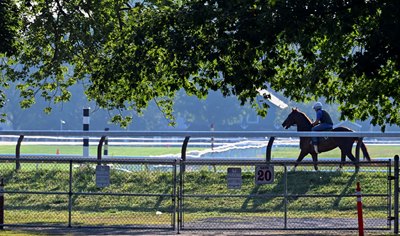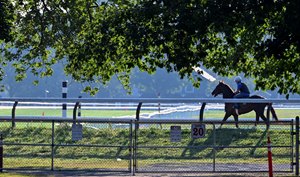Metivier is Always First on the Scene


Richard “Kerry” Metivier, who runs a stable that is quite literally home-grown, will be among the first trainers to return to the Oklahoma training track across from Saratoga Race Course when the barn area opens April 15.
From breeding horses to growing his own hay on his farm in Fort Edward, N.Y., Metivier prides himself on patience, hard work, and as much personal involvement as possible in his program at the New York Racing Association's three sites.
Metivier’s stable is one of the dozens of smaller outfits that call NYRA’s racetracks home. He regularly travels between his upstate farm and Belmont Park to keep a close eye on both his racing and breeding operations, making the Oklahoma’s reopening, where training will open for the season April 17, a welcome time of the year for him and his wife, Sandy.
“I travel back and forth two or three times a week as we have 17 broodmares on the farm,” said Metivier, who currently trains six horses. “We look forward to the Oklahoma reopening as it is an absolutely perfect training surface. The horses seem to thrive over it and it’s a testament to how well it’s taken care of.”
Upstate New York is home to Metivier, who was born in Glens Falls, a small city 19 miles north of Saratoga Springs. The 57-year-old conditioner started his first horse in September of 2000 and won his first race in October of that year.
Since then, he has visited the winner’s circle an additional 44 times while maintaining a small string of horses that race primarily in the Empire State, as well as the breeding farm that he runs with his wife. Metivier has won at least one race in every year he has trained, led by a record year in 2016 that saw him post 9 victories and $467,503 in earnings.

While Metivier did not start training horses until his early 30s, his love of horses began early in his life when attending the races at Saratoga with his father, Don Metivier, a writer who covered skiing during the winters and was a press agent in horse racing during the summers in the 1970s. Metivier recalled the way the races helped pass the time during long trips to the office with his father.
“He used to take me to the press box when I was really young and I remember seeing Jaklin Klugman win,” Metivier said, reminiscing about a 1980 handicap victory by the multiple graded stakes-winner. “I got involved in racing by osmosis, just sitting there unable to say a word or touch anything. I would get bored, so I would just sit and watch race after race. My father taught me to write and I was going in that direction, but then I found training was more fun.”
It would be several years before Metivier would step into the world of horse racing professionally. He worked alongside his father in the skiing industry before finding his way to the racetrack and working as a hotwalker for trainer Stanley Hough.
“In the summers, I would tend bar and putter around, whatever I could, because there was very little to do,” Metivier said. “Somebody recommended I get a job as a hotwalker and said it was really fun. It was anything but fun. My first paycheck was $189 and I said, ‘I’m working way too hard for this kind of money.’ The assistant said I could work afternoons instead, and that’s what really got me high on racing.”
When Hough did not apply for stalls the next season, Metivier moved to the barn of conditioner Barclay Tagg before going out on his own in a very unexpected way.
“I learned as much as I could and then my father-in-law had a couple of racehorses with a guy. He said to me, ‘You’ve got to go work for my guy because he needs a hotwalker,’” said Metivier. “I said, OK,’ but two weeks into the job, he didn’t show up and disappeared into thin air. My father-in-law told me that I was going to be his trainer now. I didn’t know anything, but he told me to study up, take the test, and learn as I went. I took it, I passed, and I inherited three horses.”
It didn’t take long for Metivier to reach the winner’s circle, earning his first victory in just his third start with Eastern Comet in a claiming race in 2000 at Meadowlands.
“When I won that race, that was it,” Metivier said, with a laugh. “I was hooked.”
The transition to horse racing provided a steep learning curve for Metivier, who previously worked as a tournament director for the World Pro Ski Tour, traveling the world to put on skiing races. Metivier said mentors like Hough made the transition from ski races to horse races a bit easier.
“It was definitely a second career, but the transition wasn’t too bad,” said Metivier. “Stanley taught me so much—to be patient, to listen to them, and not to push too hard. A little bit out of every day ends up being a lot at the end of the month. A lot every day, you’ll end up with nothing at the end of the month.”

These days, Metivier runs the stable with one other employee, his trusted assistant Antonio Sanchez. The two do everything from hotwalking to picking stalls with support from exercise riders to gallop and breeze horses in the morning. Metivier’s training program relies on quality nutrition and time to keep his horses healthy and fit.
“The horses tell you what to do,” said Metivier. “You have to be patient. I keep things holistic and I don’t really use medications. I feed them well, I grow and truck down my own hay, and I use natural supplements.”
Metivier stressed the importance of smaller training outfits and applauded the performances of fellow claiming-oriented trainers at the recently concluded Aqueduct Racetrack winter meet.
“It’s nice when I open the overnight and I see a lot of my peers and think, ‘Hey, I’ve got a shot,’” said Metivier. “A lot of the smaller guys have been doing really well this winter. It’s been sprinkled among a lot of different people."
Among Metivier’s top horses is Handle the Truth , who gave him Saratoga success in 2021 when she broke her maiden in a $25,000 maiden claiming tilt for New York-breds sprinting six furlongs.
“She’s such a kind little filly. When you look at her straight on, she almost disappears,” Metivier said, with a laugh. “Every time we take her to the races, she seems to run well. She’s got so much heart and she just keeps grinding. She’s like a little ATM. When you need a little boost, you enter her.”
While her maiden victory is Handle the Truth’s only win thus far in 28-lifetime starts, she has banked $107,197 in total purse earnings with eight other on-the-board efforts, including a third-place finish in a $16,000 claiming sprint March 26 at Aqueduct.
Metivier said New York’s racing circuit is a challenging one to compete in, but well worth the effort for the purses and breeding bonuses that are up for grabs.
“It’s difficult, but it’s lucrative if you have the right horses,” said Metivier. “Handle the Truth is lucky enough to be one of the right horses. There is no better purse structure than the New York-bred program, and you can really do very well.”
Aside from his dedication to his horses on the racetrack, Metivier is a passionate supporter of Thoroughbred aftercare and retraining. While he retains many of the mares he has bred and trained to continue on to broodmare careers at his farm, Metivier rehomes any that are not destined for breeding careers, including Soaring Empress, an unraced homebred that has found a new career as a beloved sport horse in Massachusetts.
“She was one of my favorite horses I ever trained, but she couldn’t get out of her own way,” Metivier recalled. “She wasn’t cut out for the track, but I figured she would do better as a sport horse. She’s really excelled at that and the people that have her adore her.”
Soaring Empress’ story began back in 2013 when Metivier bought her dam, the unraced Known Fact mare Doyourthing, while in foal with Soaring Empress at the Fasig-Tipton Saratoga Fall Mixed Sale. The mare was 18-years-old at the time and had produced the multiple stakes-winner Distinctive Trick, as well as four other six-figure earners. Metivier saw the mare brought little attention with prospective buyers and wanted to give her a soft landing.
“I said to my wife, ‘We’ve got to buy her.’ She tried to tell me we don’t need any more horses, but I just wanted to give her a great rest of her life,” Metivier said. “The foal didn’t work out (as a racehorse), but she’s ok in another right because she makes somebody really happy.”
Metivier recalled the similar story of Professor Chaos, who he owned, trained, and bred after purchasing his mother, the Unaccounted For mare, for $100 at the Saratoga Mixed Sale in 2008. The son of Raffie’s Majesty raced 29 times and retired to the Thoroughbred Retirement Foundation’s Second Chances program at Wallkill Correctional Facility in upstate New York where he participates in the vocational training program for inmates.
“He was a stunning, gorgeous horse,” said Metivier. “He won at Saratoga for us and then got a little tendon issue and the vet said it could become serious and said he should retire. It was a little worse than we thought, so he went to the prison to be taken care of by inmates who are working to rehabilitate themselves. He’s a barn favorite and we really enjoyed having him.”
Though the profession had come to Metivier later in his life than most in his position, he has fully embraced the training lifestyle, dedicating nearly all his time to the optimal care of his horses. Metivier said it takes just one look at a horse race to remind him why his calling lies in the sport of horse racing.
“Any time I get down or the morning work seems to get boring, I go to the races in the afternoon and it’s brand new all over again,” Metivier said. “When you have one in, they don’t have to win—just running well at high odds is a reason to get up the next morning and go to the barn with a whole new-found energy to continue on. The horses give so much to us and they just really keep me going.”
